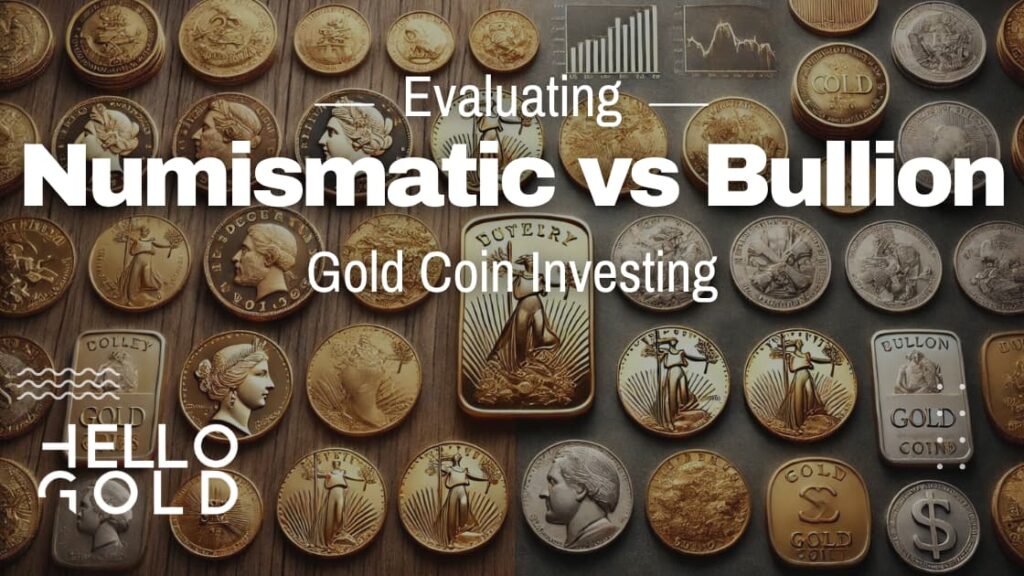You’re interested in new investment choices beyond stocks and bonds.
Gold-backed cryptocurrencies combine the stability of gold with modern digital assets.
This article explains what they are, how they work, and the good and bad points about them.
If you want to explore alternative investments for your portfolio, keep reading to learn more about this new opportunity.
Understanding Gold-Backed Cryptocurrencies
Gold-backed cryptocurrencies are an important development in the financial world, combining the stability of gold with the efficiency of blockchain technology. This new type of asset offers a unique chance for portfolio diversification and a potential shield against economic uncertainties.
What Are Gold-Backed Cryptocurrencies?
Gold-backed cryptocurrencies are digital tokens that represent ownership of a specific amount of physical gold. Unlike traditional cryptocurrencies, these tokens are tied to a real asset, providing a level of stability often missing in the unpredictable crypto market.
Each token matches a precise amount of gold stored in secure vaults. For example, Paxos Gold (PAXG) issues tokens where each represents one fine troy ounce of gold.
Similarly, Tether Gold (XAUt) allows token holders to exchange their digital assets for physical gold, creating a direct link between the digital and physical worlds of gold ownership.
The main benefits of gold-backed cryptocurrencies over traditional gold investments include:
- Better liquidity: Tokens can be traded instantly across the globe.
- Fractional ownership: Investors can buy precise amounts of gold that might be impractical with physical gold bars or coins.
- Reduced storage concerns: No need for personal secure storage facilities.
- Increased accessibility: Lower barriers to entry compared to traditional gold markets.
The Mechanics Behind Gold-Backed Tokens
The process behind gold-backed cryptocurrencies involves several key components:
Physical Gold Storage
Trusted custodians securely store gold in approved vaults. These custodians are typically well-known precious metals storage companies with a proven track record of security and reliability.
Tokenization Process
For each unit of gold stored, a matching number of tokens are created on a blockchain platform. This process is controlled by smart contracts – self-executing contracts with terms directly written into code.
Smart Contract Governance
These smart contracts ensure transparency and prevent unauthorized token creation, maintaining a strict one-to-one relationship between tokens and physical gold.
Trading Mechanisms
Tokens are traded on various cryptocurrency exchanges, similar to other digital assets. However, the unique feature is the ability to exchange tokens for physical gold, though specific methods vary between different gold-backed cryptocurrencies.
Auditing and Verification
Regular audits are conducted to verify gold reserves. These audits, often performed by respected third-party firms, ensure that the amount of gold in storage matches the number of tokens in circulation.
This process, known as proof of reserves, is crucial for maintaining the integrity and value of gold-backed cryptocurrencies.
The Gold Standard in the Digital Age
Gold-backed cryptocurrencies draw inspiration from the historical gold standard, where currencies could be directly exchanged for gold. However, this modern digital version uses blockchain technology to create a more flexible and globally accessible system.
Key aspects of this digital gold standard include:
- Stability
- Increased Liquidity
- Global Accessibility
- Technological Innovation
- Regulatory Uncertainties
- Custodial Risks
- Technological Vulnerabilities
- Market Volatility
While generally more stable than unbacked cryptocurrencies, these assets can still experience price changes based on both gold and crypto market dynamics.
Advantages of Investing in Gold-Backed Cryptocurrencies
These precious metal-backed digital assets represent a significant innovation in the realm of finance, blending the enduring value of gold with the innovative potential of digital currencies. This mix creates a unique type of asset that offers several strong advantages for investors looking to spread out their investments and protect against economic uncertainties.
Stability and Security
The main advantage of gold-backed cryptocurrencies is their stability. These digital assets are tied to physical gold safeguarded in high-security facilities, providing a level of price stability that is often missing in other cryptocurrencies.
This stability is especially clear during times of economic stress, where gold-backed tokens have shown strength compared to more volatile digital assets.
The blockchain technology behind these tokens adds an extra layer of security and openness. Each transaction is recorded on an unchangeable ledger, creating a permanent chain of ownership.
This not only improves the security of investments but also brings a new level of transparency to the gold market.
Gold-backed cryptocurrencies also offer a potential shield against inflation and currency devaluation. As central banks continue to print more money, the inherent value of gold-backed tokens, tied to the lasting worth of gold, may provide protection against the loss of purchasing power.
Liquidity and Accessibility
Gold-backed cryptocurrencies solve a common problem associated with traditional gold investments: liquidity.
These digital tokens can be traded 24/7 on various cryptocurrency exchanges, providing unmatched access to gold investments.
This constant market availability allows for more responsive investment strategies and potentially quicker execution of trades.
The fractional nature of these digital assets greatly improves accessibility.
Investors can buy exact amounts of gold, even fractions of an ounce, which was previously impractical with physical gold.
This feature opens up gold ownership to a wider range of investors.
Transaction costs for gold-backed cryptocurrencies are typically lower than those associated with traditional gold trading. While specific figures vary by platform, the reduction in middlemen and the streamlined processes enabled by distributed ledger systems often result in cost savings for investors, particularly for frequent traders or those making larger investments.
Potential for Growth
Gold-backed cryptocurrencies are uniquely positioned at the crossroads of two growing markets: precious metals and digital assets. This positioning presents interesting growth potential that goes beyond the increase in gold prices.
As digital economies continue to grow, gold-backed cryptocurrencies are well-placed to play an increasingly important role.
Their stability makes them an attractive option for international transactions, potentially driving up demand and value.
The growing interest in these assets from big investors could lead to increased adoption and potentially higher values.
The integration of gold-backed tokens with other blockchain-based financial products opens up new possibilities.
Smart contracts could use gold-backed tokens as collateral, enabling the creation of innovative investment products. This could include automated lending platforms, decentralized insurance products, and complex financial instruments, all backed by the stability of gold and the streamlined processes of distributed ledger systems.
Portfolio Diversification
Adding gold-backed cryptocurrencies to an investment strategy can significantly improve portfolio diversification. These assets typically have a low correlation with traditional investments like stocks and bonds, potentially improving the overall risk-adjusted returns of a portfolio.
Research shows that portfolios including gold-backed cryptocurrencies can perform better during market downturns while still capturing upside potential. This characteristic makes them a valuable tool for balancing investment risk and reward.
To effectively integrate gold-backed cryptocurrencies, investors should consider their overall portfolio makeup, risk tolerance, and investment goals. While there’s no one-size-fits-all allocation strategy, these assets can serve as a hedge against stock market volatility and economic uncertainties, much like traditional gold investments, while also providing exposure to the potential growth of the digital asset market.
Risks and Challenges of Gold-Backed Cryptocurrencies
Though cryptocurrencies backed by gold provide unique benefits, they also come with important risks and challenges that need careful thought. Understanding these possible problems is key for making smart investment choices.
Regulatory Uncertainties
The regulatory framework governing gold-backed digital currencies is complex and changing, which is a big challenge for investors.
In the United States, the Securities and Exchange Commission (SEC) hasn’t yet given clear guidelines on how to classify and regulate these assets.
This lack of clarity creates uncertainty for both investors and issuers.
The European Union is working towards a more standard approach through its Markets in Crypto-Assets (MiCA) regulation, but it’s not fully in place yet. Asian markets, especially Singapore and Japan, have shown openness to these assets but keep strict oversight.
Future regulations could greatly impact the value and ease of trading gold-backed tokens. Investors should be ready for possible changes in:
- Compliance requirements: Know Your Customer (KYC) and Anti-Money Laundering (AML) procedures may become stricter, affecting how easy it is to trade these assets.
- Tax implications: How these tokens are treated varies by country. Some classify them as commodities, others as securities, leading to complex reporting duties.
- Token classification: Changes in how regulators view these assets could affect their legal status and trading rules.
To handle these uncertainties, investors should stay informed about rule changes in their country and talk to tax experts familiar with digital assets.
Storage and Custodial Risks
The safety of the physical gold reserves backing these cryptocurrencies is crucial. While most issuers use strong security measures, including storage in high-security vaults and regular checks, relying on third-party custodians brings its own risks.
The reputation and track record of the custodian responsible for storing the gold is important, as is how often and openly they conduct audits. Investors should look for tokens backed by gold reserves that undergo frequent, independent audits with publicly available results.
Understanding the extent of insurance coverage for the gold reserves is also essential, as not all policies offer full protection against theft or loss.
Additionally, investors should familiarize themselves with how token redemption works. Some tokens, like Tether Gold (XAUt), allow for physical gold redemption, but the process may have limits based on location and minimum amounts.
Compared to traditional gold storage methods, gold-backed cryptocurrencies offer convenience but may not provide the same level of direct ownership and control as physical gold holdings. This trade-off between convenience and direct control is an important point for potential investors to consider.
Market Volatility
Despite being backed by gold, these cryptocurrencies are not immune to market swings.
During the COVID-19 pandemic, some gold-backed cryptocurrencies like Digix Gold and Midas Touch Gold showed big price changes similar to Bitcoin, challenging the idea that they’re stable.
This volatility can be due to various factors, including overall feelings in the cryptocurrency market, changes in the spot price of gold, and supply and demand dynamics within the specific token ecosystem.
Limited liquidity in some gold-backed tokens can lead to significant price swings during high trading activity or market stress.
To manage these risks, investors should consider spreading their investments beyond a single gold-backed cryptocurrency. Using strategies such as dollar-cost averaging when investing can help reduce the impact of short-term volatility.
Setting stop-loss orders can protect against sudden price drops, while actively watching both gold and cryptocurrency markets can help anticipate potential price movements.
Technological Risks
Gold-backed cryptocurrencies face various technological risks inherent to blockchain technology.
Smart contract vulnerabilities are a main concern, as flaws in the code governing these tokens could potentially be exploited, leading to unauthorized token creation or theft.
Cybersecurity threats also loom large, with exchanges and wallet providers being potential targets for hackers.
The cryptocurrency space has seen numerous security breaches resulting in significant losses for investors.
Private key management presents another unique challenge. Unlike traditional gold investments, the loss of private keys can result in permanent loss of assets.
This risk underscores the importance of secure storage practices for digital assets. Additionally, changes to the underlying blockchain, such as forks or upgrades, could potentially impact token holders, requiring careful attention to any proposed updates.
To reduce these technological risks, investors should consider using reputable exchanges and wallet providers with strong security track records.
For long-term storage of significant holdings, hardware wallets offer an added layer of security.
Regularly updating software and security measures is crucial, as is staying informed about any proposed changes or upgrades to the blockchain supporting the gold-backed tokens.
Spreading holdings across multiple wallets can also help mitigate the consequences of a single point of failure.
Comparing Gold-Backed Cryptocurrencies to Other Investments
Gold-backed cryptocurrencies are a unique mix of traditional and digital assets, giving investors a new way to own gold. This section compares these new assets with both traditional gold investments and other digital assets, highlighting key differences in ownership, ease of buying and selling, tax issues, and potential returns.
Traditional Gold Investments vs. Gold-Backed Crypto
Ownership and Storage
Traditional gold investments usually involve owning physical gold, like bars or coins. This real ownership comes with the need for secure storage, often requiring safety deposit boxes or home safes.
The costs and security risks can be high, especially for larger amounts.
On the other hand, gold-backed cryptocurrencies offer digital ownership through tokens, with the physical gold kept by professional custodians.
This setup removes personal storage worries but adds the risk of trusting someone else. Investors must trust the issuer to keep the gold reserves and allow redemptions.
For everyday investors, gold-backed cryptocurrencies make it easier to own gold without the hassle of physical storage. Big investors might appreciate the simplicity of managing large gold positions digitally, but may worry about the changing rules around these newer assets.
Ease of Buying and Selling
Gold-backed tokens are generally easier to buy and sell compared to physical gold. These digital assets are available for transaction around the clock on cryptocurrency exchanges, allowing for quick trades and easy portfolio changes.
Physical gold, while valuable, may take more time and effort to sell, especially in larger amounts.
The advantage of easily trading gold-backed crypto is especially clear in tough market times. As global lockdowns disrupted traditional markets, some investors had trouble selling physical gold due to shipping problems, while gold-backed tokens were still easy to trade.
Tax Issues
The tax treatment of gold-backed cryptocurrencies can be tricky and varies a lot depending on where you live.
In some cases, they could face taxation similar to physical gold, while in others, they may be subject to the same tax rules as other cryptocurrencies.
This uncertainty can make tax reporting hard for investors.
For example, in the United States, physical gold is currently taxed as a collectible with a maximum long-term capital gains rate of 28%.
Gold-backed cryptocurrencies, however, might be treated differently depending on how they’re set up and how long they’re held.
It’s important for investors to talk to tax experts who are well-versed in both traditional commodities and blockchain-based investments to understand these complex issues.
Trading Costs
Gold-backed cryptocurrencies often have lower trading costs compared to buying and selling physical gold, which can involve high markups, shipping, and insurance costs. However, it’s important to look at all the fees, including storage fees for the underlying gold and any blockchain transaction fees.
While buying physical gold might cost 5-10% more than the market price, plus shipping and insurance, trading gold-backed tokens typically involves much lower fees, often less than 1%. However, some gold-backed crypto platforms charge yearly storage fees, usually around 0.25-0.5%, which should be considered when thinking about long-term costs.
Gold-Backed Crypto vs. Other Digital Assets
Stability
Gold-backed cryptocurrencies generally have more stable prices compared to cryptocurrencies like Bitcoin or Ethereum that aren’t backed by anything.
However, they can still experience value fluctuations influenced by trends in both precious metals and digital asset markets.
This dual influence can lead to interesting price behaviors.
During times of economic uncertainty, gold-backed tokens might see increased demand because gold is seen as a safe investment, while also benefiting from growing interest in the broader cryptocurrency market. This unique position can make them attractive for investors looking to reduce portfolio risk without completely leaving the digital asset space.
Unique Features
Gold-backed tokens merge the time-tested value of precious metals with the cutting-edge capabilities of blockchain technology. This allows for potential use with smart contracts and decentralized finance (DeFi) applications, opening up new possibilities for gold as an asset.
One notable development is the use of gold-backed tokens in yield farming and providing liquidity on decentralized exchanges. This allows investors to earn extra returns on their gold holdings, something not possible with traditional gold investments.
DeFi Potential
The stability of gold-backed tokens makes them attractive for use as collateral in DeFi lending platforms or as a store of value in decentralized exchanges. This integration into the DeFi ecosystem could potentially increase demand for these tokens and provide additional uses beyond simple gold exposure.
Some DeFi platforms are experimenting with gold-pegged digital assets as a stable collateral option for loans, potentially offering lower interest rates due to the perceived stability of the underlying asset.
Risk and Return Profile
While gold-backed cryptocurrencies may offer more stability than unbacked cryptos, they typically don’t have the same potential for huge growth. They can serve as a way to protect against big price swings in a diverse digital asset portfolio.
When building a digital asset portfolio, consider putting some money into gold-backed tokens as a stabilizing force. For example, a portfolio might include 60% major cryptocurrencies for growth potential, 30% stablecoins for keeping capital safe, and 10% gold-backed tokens for protection against inflation and reduced price swings.
Practical Considerations for Tech-Savvy Investors
These innovative financial instruments combine time-honored precious metals with modern blockchain technology. For investors looking to explore this hybrid asset class, understanding the practical aspects is crucial for making smart decisions and getting the most out of potential benefits.
Evaluating Your Investment Goals
Before considering gold-backed cryptocurrencies, investors must match these assets with their broader financial goals.
The investment timeline plays a key role in shaping strategy. Those with short-term goals might focus on taking advantage of market inefficiencies, while long-term investors typically prioritize protection against inflation and keeping value.
Risk tolerance is another critical factor to consider. While gold-backed tokens generally offer more stability than their unbacked counterparts, they still experience price changes influenced by both gold and crypto markets.
A thorough analysis of past price data can provide insights into potential ups and downs, helping investors gauge their comfort level with these assets.
Strategic fit is equally important.
Gold-backed cryptocurrencies can serve multiple purposes within a portfolio, acting as a shield against economic uncertainties, a way to spread out investments, or a means of gaining exposure to both gold and blockchain technology.
Investors should carefully consider how these assets fit into their overall investment strategy.
Setting realistic return expectations is crucial. Unlike speculative digital assets, gold-backed cryptocurrencies typically don’t offer explosive growth potential. Instead, they provide steady growth and can serve as a financial safeguard during economic downturns.
Developing a personal investment plan, based on data and aligned with overall financial goals, can help clarify the role of these assets in an investor’s portfolio.
Getting Started with Gold-Backed Cryptocurrencies
Once investment goals are clear, the next step is selecting a trustworthy platform or exchange.
Key factors to consider include regulatory oversight, transparent auditing practices, and strong security measures.
Platforms like Paxos Gold, operating under the New York State Department of Financial Services, offer an additional layer of trustworthiness.
Regular third-party audits of gold reserves and comprehensive cybersecurity protocols are also crucial elements to look for.
Understanding the cost structure is vital for accurately projecting the total cost of ownership. This includes transaction fees, storage fees, and redemption fees.
Some platforms, like Perth Mint Gold Token, don’t charge storage fees, which can significantly impact long-term returns.
Comparing fee structures across platforms and noting any volume-based discounts can help investors optimize their cost efficiency.
The process of making the first investment involves several steps. It begins with account creation, which typically requires completing Know Your Customer (KYC) procedures.
Implementing strong security measures, such as two-factor authentication, is crucial.
When funding the account, consider the most cost-effective method, whether it’s wire transfer, ACH, or cryptocurrency transfer.
For the actual token purchase, using limit orders can help control the entry price, especially in volatile market conditions.
After purchase, transferring tokens to a secure wallet, preferably a hardware wallet for large holdings, is advisable.
Ongoing management of gold-backed cryptocurrency investments requires vigilance.
Implementing a robust backup strategy for private keys, including offline storage in multiple secure locations, is essential.
Regular updates to wallet software and security protocols help maintain the integrity of the investment.
Staying informed about market movements, regulatory changes, and technological advancements is also crucial for making timely decisions.
Integrating Gold-Backed Crypto into a Diversified Portfolio
Incorporating gold-backed cryptocurrencies into an investment strategy requires careful planning and ongoing management.
The allocation strategy should be based on the investor’s risk profile and investment goals.
A common approach for those new to the asset class is to start with a 5-10% allocation, adjusting as experience and comfort with the investment grow.
Maintaining the target allocation requires a systematic rebalancing strategy. This can be achieved through time-based rebalancing, where the portfolio is reviewed and adjusted at set intervals, or threshold rebalancing, triggered when the allocation deviates by a predetermined percentage from the target.
Gold-backed cryptocurrencies should be considered in the context of the entire portfolio. They can complement traditional gold investments, providing a multi-faceted approach to precious metals exposure.
Balancing these assets with other alternative investments like real estate or commodities can create a well-rounded alternative asset allocation.
Sophisticated portfolio management tools that can incorporate both traditional and digital assets are invaluable for tracking and analysis. Platforms offering real-time portfolio valuation across multiple asset classes and analytics tools to assess the impact of gold-backed cryptocurrencies on overall portfolio risk and return profile can provide crucial insights for decision-making.
A case study from the market volatility of 2020 illustrates the potential benefits of integrating gold-backed cryptocurrencies into a diversified portfolio.
An investor who allocated 10% of their portfolio to these assets experienced several advantages. The gold-backed tokens helped stabilize the portfolio by offsetting losses in more volatile asset classes.
The high liquidity of these tokens allowed for quick portfolio rebalancing, enabling the investor to capitalize on market opportunities without the delays associated with physical gold transactions. Additionally, this investment provided exposure to blockchain technology, positioning the portfolio to benefit from potential future innovations in the financial sector.
Future Outlook for Gold-Backed Cryptocurrencies
The gold-backed cryptocurrency market is set for big changes, offering new chances and challenges for investors looking for different assets. This section looks at the possible tech advances and market trends that could shape the future of these digital assets.
Technological Advancements and Innovation
Blockchain technology, which forms the foundation for digital currencies backed by gold, is expected to see big improvements in speed and efficiency.
New token standards are likely to come up, making it easier for different systems to work together and potentially leading to faster transactions and lower costs.
These improvements could make gold-backed tokens more useful for everyday transactions and maybe more attractive for investment portfolios.
The combination of Internet of Things (IoT) devices with blockchain technology offers a chance to change how we track and secure physical gold reserves.
Smart sensors could give real-time data on gold storage conditions, movement, and authenticity.
This increased openness may address one of the main concerns in digital gold ownership: the provable link between the token and the actual gold.
Artificial Intelligence (AI) is set to play a big role in improving the security and efficiency of gold-backed cryptocurrency platforms.
AI algorithms could be used to spot fraud, improve trading strategies, and give more accurate price predictions based on complex market data analysis.
This tech combo could offer more advanced tools for managing gold-backed crypto investments.
The rise of quantum computing brings both challenges and opportunities for blockchain security.
While quantum computers could potentially break current security methods, they also offer the chance to develop quantum-resistant encryption methods.
This development is crucial for ensuring the long-term security of gold-backed digital assets.
In the next 5-10 years, gold-backed tokens are likely to change into more complex financial tools.
Smart contracts could enable automated lending platforms using gold-linked digital currencies as security, or help create sophisticated derivatives products.
This change may open up new ways to use gold holdings, potentially making these assets more useful and attractive in investment portfolios.
Market Adoption and Institutional Interest
Big financial players are showing more interest in gold-backed cryptocurrencies. They’re exploring these assets as a way to combine the enduring stability of precious metals with cutting-edge digital ledger systems.
This trend is likely to speed up as rules become clearer and more supportive, potentially leading to increased liquidity and stability in the market.
The potential for widespread use goes beyond investment.
Gold-backed cryptocurrencies could be used in international trade, serving as a stable way to exchange value that goes beyond national currencies.
This could be especially helpful for deals involving countries with unstable currencies or complex foreign exchange rules.
As more people use these assets, it could greatly affect traditional gold markets. Increased liquidity and easier access to gold through digital tokens might lead to more efficient pricing and potentially change global gold demand patterns.
This could affect how investors approach gold as part of their investment strategy, potentially offering more flexible ways to invest in the precious metal.
Central banks and governments will be instrumental in shaping the future of gold-backed cryptocurrencies.
Some may see these assets as a threat to their control over money, while others might see opportunities for more efficient gold reserve management.
The rules that emerge will significantly influence how these digital assets grow.
If gold-backed cryptocurrencies become widely accepted, it could have far-reaching effects on the global economy.
They could potentially influence monetary policy, impact currency markets, and even challenge the dominance of government-issued money in certain situations.
This could create new ways of thinking about money and how we store value.
The combination of gold-backed cryptocurrencies with emerging technologies like IoT and AI is expected to improve security measures around these assets. For example, IoT devices could be used to monitor and secure gold storage facilities, improving the safety of physical reserves through advanced surveillance and biometric authentication.
As the market for gold-backed cryptocurrencies grows, we’re likely to see more sophisticated financial products.
Decentralized finance (DeFi) principles are being added to these assets, offering more secure, private, and compliant alternatives to traditional financing methods.
This could open up new possibilities for leveraging precious metal-linked digital assets in revenue-generating protocols, facilitating trading on peer-to-peer platforms, or as collateral in various DeFi applications.
Closing
Gold-backed cryptocurrencies combine gold’s stability with blockchain’s efficiency. They can help diversify your investments and protect against economic troubles.
But be aware of rules, storage, and tech risks. To start, check if your investment goals fit and choose a trusted platform. Put 5-10% of your money into these assets.
Keep up with changes in the market and new tech in this area. Make smart choices that match your long-term plans.
Your next step: learn more about specific gold-backed cryptocurrencies and how they might work with your investment strategy.











